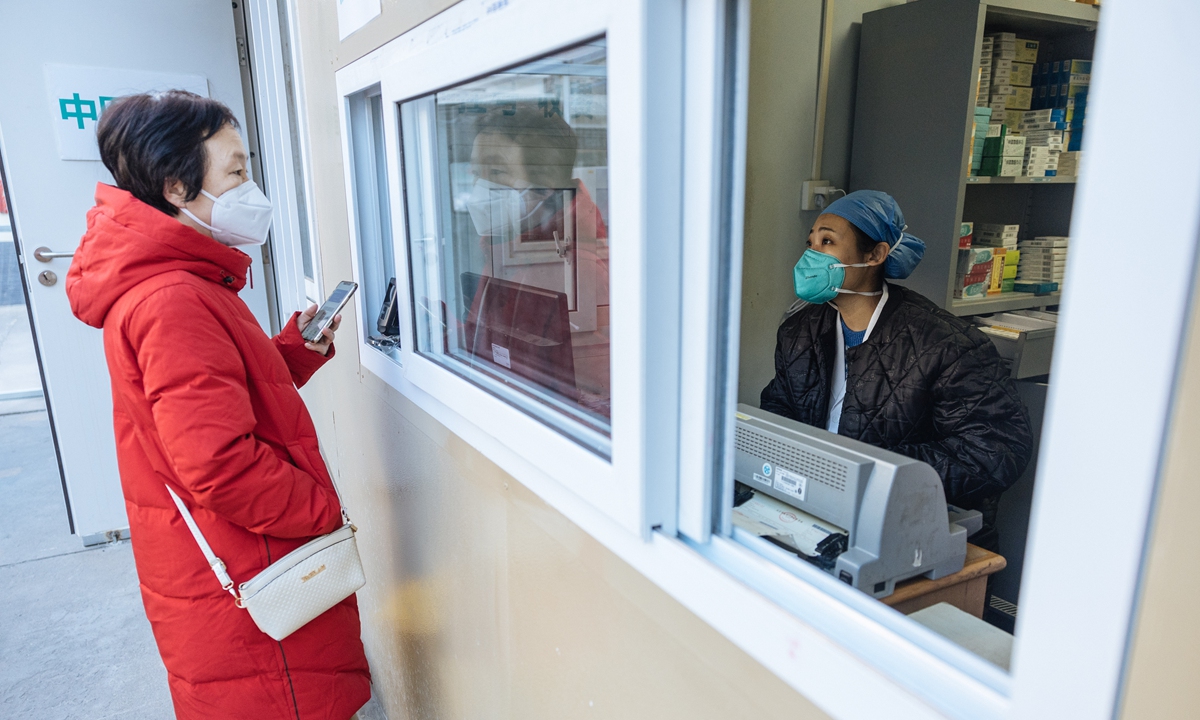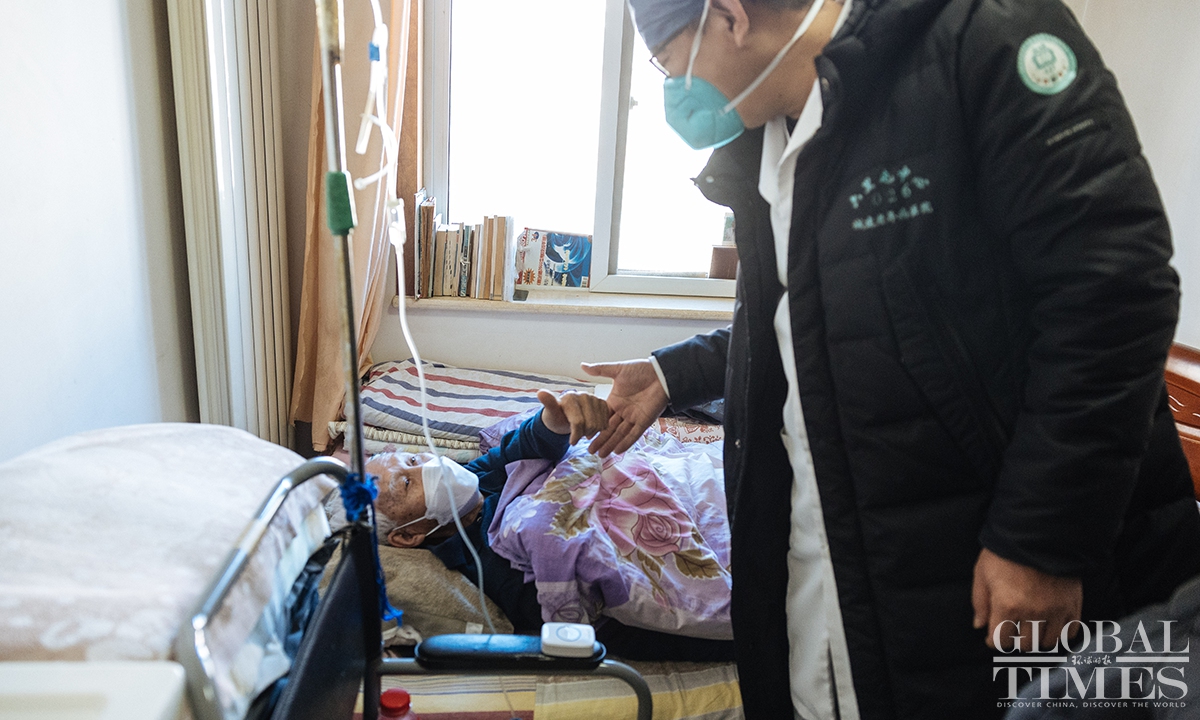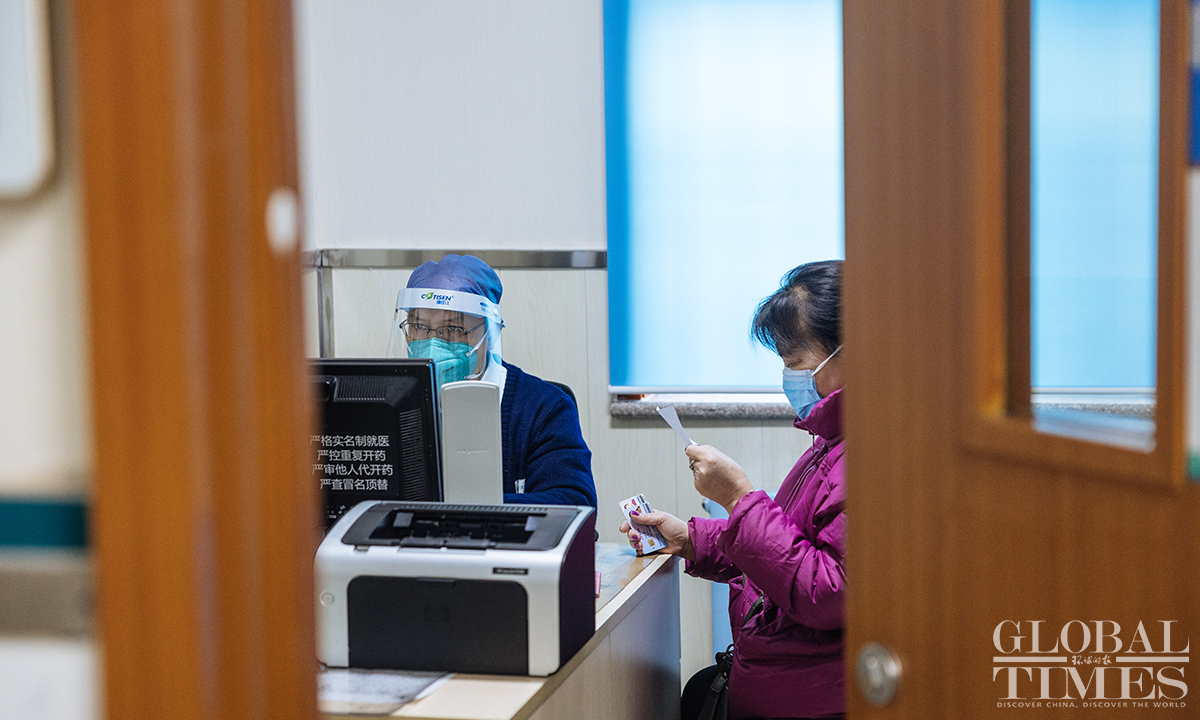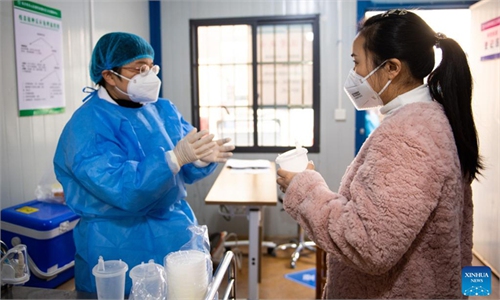
A community hospital in Beijing Photo: Li Hao/GT
Getting the physician's bag ready early in the morning, nurse Wang Qinghua and doctor Yue Xinfeng directly headed to the home of an 88-year-old patient, who tested positive for COVID-19 and has multiple underlying problems, for a drip and routine home visit.
Since Cao Guangbin got infected and bedridden in December, Wang and Yue from Liulitun Community Health Center in Chaoyang district, Beijing have been taking care of him. After about 10-days of thorough treatment of the community hospital, Cao, who was too ill to function alone, now is able to walk on the ground and go to the bathroom by himself, Cao's son said.
Cao is one of some 1,300 patients who have registered Yue as a family doctor at the community level. About 60-70 percent of them are elderly people aged above 65. Yue makes three to five home visits every day, sometimes even eight times to check if they are okay.
Wang and Yue are among hundreds and thousands of nurses and doctors in community hospitals of China who now engage in COVID-19 frontline, busy with taking care of COVID-19 patients, especially those high-risk population with underlying diseases. Since China optimized COVID-19 response measures, the country shifted its focus from curbing off infection to shoring up resources to prevention of severe cases.
In contrast to what Western media claimed - "the country is ill-prepared for big spike in cases" - community hospitals have made a slew of practical preparations, including construction of fever clinics and transferring cases to hospitals, to cope with surging COVID-19 infections and protect the health of the people.
Practical preparations

Photo: Li Hao/GT
If there is no timely medical treatment given by the Liulitun Community Health Center, Cao's son said he would probably never see his father again.
Benefiting from the country's earlier deployment of checking high-risk populations, Cao was able to get in contact with doctors and nurses in the community hospital in the very beginning since he got infected because his information had already been registered by the community hospital.
Liu Yunjie, the head of the Liulitun Community Health Center, told the Global Times that following the country's mechanism of giving tiered diagnosis and treatment to COVID-19 patients, his community hospital has followed health status of elderly patients within its administrative sphere, including those who live alone, and have underlying diseases.
"Because of these earlier screening, the community doctors at our hospital have a prognosis about who might develop into a severe case. We pay close attention to them. Once they tend to turn into a severe case, they would be delivered to a higher level medical institution," Liu said.
Since China announced the optimized 10-point COVID-19 response on December 7, health authorities have also released all-round guidelines coaching people who test positive for COVID-19 how to react to the infection at home, instructing community hospitals how to shoulder their responsibilities in assisting residents to get through their infections and give them proper medical treatment.
The State Council joint prevention and control mechanism against COVID-19 called on grassroots medical institutions to take more measures to prevent and reduce severe cases in its newly released notice on Tuesday.
Training of grassroots medical staff including doctors in the countryside should be strengthened to boost their skills in classifying COVID-19 patients, diagnosing and treating patients, including offering advice for home quarantine and early detection of hypoxemia and breathing difficulties, the notice said.
More support and guidance from upper-level hospitals should be given to grassroots medical institutions, the notice stated, like the standard use of small molecule drugs to level up their capability to treat severe cases and set up online channels to address shortage of manpower in some grassroots health institutions.
To play a better role in tiered diagnosis and treatment mechanism, the community hospital has turned 61 patient beds from the orthopedics department into receiving patients from the internal medicine department and arranged medical staff for professional training at Chaoyang Hospital. With a total of 250 patient beds, the community hospital now not only has enough capacity to treat severe patients but also receive transferred patients from Chaoyang Hospital who are in their rehabilitation period.
As part of their preparations, Liulitun Community Health Center also purchased drugs in reserve and compounded traditional Chinese medicine based on schemes of health authorities, Liu told the Global Times. "It is common knowledge that winter is a high season for influenza, cardiovascular and cerebrovascular diseases. Our early deployment guarantees the COVID-19 patients' drug demand.''
Before the country decided to optimize COVID-19 responding policy, the community hospital had already seen increasing demand for medical treatment. To address the high demand, Liu set up outdoor temporary tents in advance to receive increasing fever patients.
"Patients are able to see the doctor and fetch their drugs within the makeshift facility at the same time. I received some 50 patients in one day. Because of the earlier preparations, what I need to do is expand and transform the makeshift facilities into a designated area for COVID-19 patients with fever, after December 7."
The community center now receives an average of about 400 patients with fever and other COVID-19 symptoms every day and during the peak period in early December, the daily diagnosis amount surpassed 600. From December 6 to December 31, more than 7,000 people received medical treatment there, the Global Times learnt.
Community hospitals are more easily accessible compared with large hospitals due to psychological attachment. Especially receiving patients with light symptoms could largely reduce pressure on large hospitals, observers said.
Yue still remembers the busy days when he received long queues of COVID-19 patients in front of the fever clinics. He said especially on December 8 and 9, when many medical staff were infected, one doctor on duty received some 1,400 patients in two days. The peak period lasted until December 26 and December 27. Many of them returned to their jobs only after three days of rest.
Protect residents' health

Photo: Li Hao/GT
Zhang Wenhong, a prominent Chinese epidemiologist said, since China allows home quarantine, it is estimated that 99 percent of the patients will be concentrated in grassroots community medical institutions. The key to getting out of the epidemic lies in community doctors, the grassroots level of tiered treatment, and adequate stocks of drugs, Zhang said.
Community hospitals are more of a gatekeeper for residents' health and have done lots of practical preparations for guaranteeing their health during the country's COVID-19 exit wave.
After weeks of concentrated efforts, Beijing has managed to go through the infection peak, said Wang Guangfa, a respiratory expert from Peking University First Hospital. But community hospitals will continue to play their role in classifying COVID-19 patients and give proper treatment to reduce the rate of severe cases.
Due to timely adjustment and optimization made by health authorities and the government, the epidemic in China is basically under overall control, though there are short periods of strained medical resources in some regions, observers said.
Claims from Western media saying "the country is ill-prepared for big spike in cases" or "epidemic is out of control" are merely political hype-ups used to mislead the international community and smear against China. It contradicts the facts in grassroots medical institutions, where Chinese medical staff and the government are pouring in everything to protect the health of the people, they noted.



